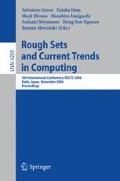Abstract
Flow graph (FG) is a unique approach in data mining and data analysis mainly in virtue of its well-structural characteristics of network, which is naturally consistent with granular computing (GrC). Meanwhile, GrC provides us with both structured thinking at the philosophical level and structured problem solving at the practical level. The main objective of the present paper is to develop a simple and more concrete model for flow graph using GrC. At first, FG will be mainly discussed in three aspects under GrC, namely, granulation of FG, some relationships and operations of granules. Moreover, as one of advantages of this interpretation, an efficient approximation reduction algorithm of flow graph is given under the framework of GrC.
Access this chapter
Tax calculation will be finalised at checkout
Purchases are for personal use only
Preview
Unable to display preview. Download preview PDF.
References
Butz, C.J., Yan, W., Yang, B.: The Computational Complexity of Inference using Rough Set Flow Graphs. In: [14], pp. 335–344 (2005)
Lin, T.Y.: Granular Computing on Binary Relations I: Data Mining and Neighborhood Systems. In: Skoworn, A., Polkowski, L. (eds.) Rough Sets In Knowledge Discovery, pp. 107–121. Springer, Heidelberg (1998)
Lin, T.Y., Yin, P.: Heuristically Fast Finding of the Shortest Reducts. In: [16], pp. 465–470 (2004)
Pawlak, Z.: Decision Networks. In: [16], pp. 1–7 (2004)
Pawlak, Z.: Decisions rules and flow networks. European Journal of Operational Research 154, 184–190 (2004)
Pawlak, Z.: Flow graphs and decision algorithms. In: Wang, G.Y., et al. (eds.) Rough Sets,Fuzzy Sets,Data Mining and Granular Computing, pp. 1–11. Springer, Heidelberg (2003)
Pawlak, Z.: Flow Graphs and Data Mining. In: Peters, J.F., Skowron, A. (eds.) Transactions on Rough Sets III, pp. 1–58. Springer, Heidelberg (2005)
Pawlak, Z.: In Pursuit of Patterns in Data Reasoning from Data - The Rough Set Way. In: Proceedings of the 3rd of Rough Sets and Current Trends in Computing, pp. 1–9 (2002)
Pawlak, Z.: Probability,truth and flow graphs. In: Proceedings of the Workshop on Rough Sets in Knowledge Discovery and Soft Computing at ETAPS, pp. 1–9 (2003)
Pawlak, Z.: Rough Sets and Flow Graphs. In: [14], pp. 1–11 (2005)
Pawlak, Z.: Some Issues on Rough Sets. In: [12], pp. 1–58 (2004)
Peters, J.F., Skowron, A. (eds.): Transactions on Rough Sets I. Springer, Berlin (2004)
Skowron, A., Stepaniuk, J.: Information granules: towards foundations of granular computing. International Journal of Intelligent Systems 16, 57–85 (2001)
Ślȩzak, D., et al. (eds.): Rough Sets, Fuzzy Sets, Data Mining and Granular Computing. Springer, Berlin (2005)
Sun, J., Liu, H., Zhang, H.: An Extension of Pawlak’s Flow Graphs. In: Proceedings of the 1st International Conference on Rough Sets and Knowledge Technology, Chongqing, China (to appear, 2006)
Tsumoto, S., Słowiński, R., Komorowski, J., Grzymała-Busse, J.W. (eds.): RSCTC 2004. LNCS (LNAI), vol. 3066. Springer, Heidelberg (2004)
Yao, Y.Y.: A partition model of granular computing. In: [12], pp. 232–253 (2004)
Yao, Y.Y.: Perspectives of Granular Computing. In: Proceedings of 2005 IEEE International Conference on Granular Computing, vol. 1, pp. 85–90 (2005)
Yao, Y.Y., Zhong, N.: Granular computing using information tables. In: Lin, T.Y., Yao, Y.Y., Zadeh, L.A. (eds.) Data Mining, Rough Sets and Granular Computing, pp. 102–124. Physica-Verlag, Heidelberg (2002)
Zhang, L., Zhang, B.: The quotient space theory of problem solving. In: Wang, G.Y., et al. (eds.) Rough Sets,Fuzzy Sets,Data Mining and Granular Computing, pp. 11–15. Springer, Heidelberg (2003)
Zhang, C., Zhang, S. (eds.): Association Rule Mining. LNCS (LNAI), vol. 2307. Springer, Heidelberg (2002)
Author information
Authors and Affiliations
Editor information
Editors and Affiliations
Rights and permissions
Copyright information
© 2006 Springer-Verlag Berlin Heidelberg
About this paper
Cite this paper
Sun, J., Liu, H., Qi, C., Zhang, H. (2006). An Interpretation of Flow Graphs by Granular Computing. In: Greco, S., et al. Rough Sets and Current Trends in Computing. RSCTC 2006. Lecture Notes in Computer Science(), vol 4259. Springer, Berlin, Heidelberg. https://doi.org/10.1007/11908029_47
Download citation
DOI: https://doi.org/10.1007/11908029_47
Publisher Name: Springer, Berlin, Heidelberg
Print ISBN: 978-3-540-47693-1
Online ISBN: 978-3-540-49842-1
eBook Packages: Computer ScienceComputer Science (R0)

